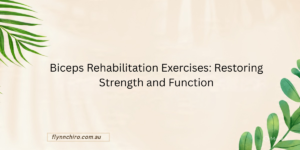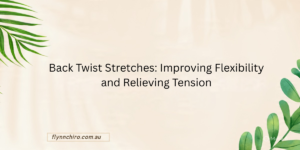
Biceps Rehabilitation Exercises: Restoring Strength and Function
The biceps are one of the most recognisable muscles in the body, but their role extends far beyond appearance. Located at the front of the upper arm, they are responsible for bending the elbow and rotating the forearm, while also assisting the shoulder joint in lifting and stabilising movements.
When the biceps are injured or weakened—whether from overuse, poor posture, or an acute strain—everyday tasks such as lifting, reaching, or even typing can become uncomfortable. Biceps Rehabilitation Exercises play a vital role in restoring strength, coordination, and flexibility, supporting healing and preventing future injury.
A structured Biceps Rehabilitation Exercises programme focusing on gradual activation and controlled movement helps rebuild the muscle safely. At Flynn Chiro Melbourne CBD and Flynn Chiro Prahran, these exercises form an important part of a complete recovery plan. Each session is tailored to your condition and goals, helping you regain confidence in movement, restore balance, and achieve lasting functional improvement.
The Purpose of Biceps Rehabilitation
After injury or surgery, the biceps often lose strength and coordination. Rest alone is rarely enough; targeted exercise helps re-educate the muscle and improve circulation to aid tissue repair. Rehabilitation begins with simple isometric exercises before progressing to more dynamic strengthening and stretching.
The aim is to achieve full, pain-free range of motion and build resilience so that the muscle can handle daily demands. Just as importantly, these exercises help restore balance across the upper arm and shoulder region, ensuring all muscles work together efficiently.
What Are Isometric Exercises?
Isometric exercises involve contracting a muscle without changing its length or moving the joint. They are ideal for early rehabilitation when active movement might still cause discomfort.
Because they create muscle tension without joint motion, they help maintain strength and stimulate healing without stressing the injured tissue. This makes them a safe and effective way to begin reactivation after a period of rest or immobilisation.
Performing Biceps Isometric Exercises

These exercises can be performed twice daily. They require no equipment and can be done almost anywhere, provided posture and breathing remain relaxed.
Right Arm Isometric Hold
Bend the right elbow to a 90-degree angle and hold it close to the body. Place the left hand over the right forearm and gently try to bend the right elbow upwards while resisting the movement with the left hand. The key is to keep the elbow still—the muscle should contract without any visible motion.
Hold the tension for about twenty seconds before relaxing. Repeat three times. This gentle contraction activates the biceps, encouraging blood flow and helping rebuild strength in a controlled manner.
Left Arm Isometric Hold
Switch sides and repeat the same movement. Keep the shoulders relaxed, chin level, and spine tall throughout. Hold for twenty seconds and repeat three times.
These static holds may feel subtle at first, but with consistent practice, they help restore muscle tone and stability without straining the healing tissues.
Stretching the Biceps for Flexibility
Once the initial strength begins to return, stretching helps maintain flexibility and prevent stiffness. Tight biceps can restrict shoulder motion and even affect posture, so this step is just as vital as strengthening.
Wall-Assisted Biceps Stretch

Stand side-on to a wall with the right palm pressed flat against it. Keep the elbow straight and slowly turn the body away from the wall until a mild stretch is felt across the front of the shoulder and upper arm. Hold the position for fifteen to twenty seconds while breathing deeply, then relax.
Repeat on the opposite side and perform this sequence twice a day. The stretch should feel comfortable and not forced. With time, this gentle movement improves flexibility and reduces residual tightness around the shoulder and elbow.
Progressing Safely Through Rehabilitation
Rehabilitation is about gradual progression. Once isometric exercises and gentle stretching are performed comfortably, light resistance training can be introduced—typically using a resistance band or small weights.
The purpose at this stage is to retrain coordination between the biceps and surrounding muscles, particularly the shoulder stabilisers and forearm flexors. Controlled curls and rotation movements under supervision help re-establish functional strength.
It’s important to remember that everyone heals at a different rate. Attempting advanced exercises too soon may delay recovery, so professional guidance ensures progression remains safe and effective.
Common Mistakes During Biceps Rehabilitation
Even simple exercises can lose effectiveness if performed incorrectly. Attention to technique and posture makes a considerable difference in outcomes.
One common error is holding the breath during effort. This increases tension and can restrict blood flow. Breathing steadily throughout each contraction helps maintain control and relaxation. Another mistake is using excessive force, which can overstrain the healing tendon. The goal of early rehabilitation is gentle activation, not maximum strength.
Postural alignment also matters. Slumping forward or rounding the shoulders can shift tension to the neck and upper back. Keeping the spine neutral and the shoulders relaxed ensures the biceps work efficiently without compensation. Lastly, rushing recovery often leads to setbacks. Consistency and patience bring the best long-term results.
The Importance of Posture in Biceps Health
Good posture has a direct effect on how the biceps and surrounding muscles function. Forward-rounded shoulders or prolonged sitting can cause the front of the shoulder to tighten, placing ongoing strain on the biceps tendon. Over time, this may result in fatigue, discomfort, or reduced mobility.
Correcting posture—both through conscious awareness and supportive chiropractic care—relieves pressure on the upper arm and encourages healthier movement patterns. As alignment improves, so does the efficiency of the biceps and shoulder complex.
The Role of Chiropractic Care in Rehabilitation
While exercises are essential, recovery rarely happens in isolation. Chiropractic care complements biceps rehabilitation by addressing structural and functional imbalances throughout the upper body.
Misalignments in the shoulder, neck, or spine can alter movement mechanics, increasing stress on the biceps. Chiropractic adjustments help restore normal joint motion, reduce muscular tension, and improve nerve communication between the brain and muscles.
At Flynn Chiro, treatment often combines manual adjustments with soft-tissue therapy, stretching, and personalised exercise plans. This integrated approach not only speeds recovery but also enhances overall movement quality and posture.
Supporting Recovery with Lifestyle and Ergonomics
Outside of structured exercises, everyday habits can either support or hinder recovery. Paying attention to workstation ergonomics—such as keeping screens at eye level and shoulders relaxed—prevents unnecessary strain on the upper body.
Staying hydrated and maintaining a balanced diet rich in protein and anti-inflammatory foods supports tissue healing. Gentle movement throughout the day, such as stretching the arms and rolling the shoulders, prevents stiffness from returning.
Small, consistent changes in daily habits often make the difference between short-term relief and lasting improvement.
How Consistency Creates Long-Term Strength
Rehabilitation is most successful when exercises become part of a daily routine. Short, frequent sessions help the body adapt gradually and reinforce positive patterns. Missing sessions occasionally won’t derail progress, but consistency ensures that the muscle regains its natural strength and responsiveness.
Each exercise session builds on the last, and the improvements accumulate over time. With patience and persistence, the biceps regain their full function—supporting not only arm movements but also the balance and stability of the entire upper body.
Flynn Chiro: Guiding Recovery Every Step of the Way
At Flynn Chiro, rehabilitation is viewed as a journey rather than a quick fix. With clinics in Melbourne CBD and Prahran, patients receive individualised care tailored to their specific needs.
The approach combines evidence-based chiropractic adjustments, hands-on therapy, and targeted exercise programmes. Every plan is designed to support healing, restore function, and promote better movement patterns across the whole body.
Whether recovering from a sports injury, repetitive strain, or general muscle tightness, the goal is always the same—to help patients move comfortably and confidently again. By addressing both the cause and the symptoms, Flynn Chiro provides comprehensive support for lasting results.
Final Thoughts
The biceps play an essential role in how the arm and shoulder function together. When injured, they remind us how much we rely on even small movements in everyday life. Rehabilitation is about more than rebuilding muscle; it’s about restoring harmony between movement, posture, and strength.
Through consistent isometric exercises, gentle stretching, and professional chiropractic guidance, it’s possible to achieve full recovery and prevent future injury. Each step in the process contributes to a stronger, more resilient body capable of moving freely without pain or hesitation.
At Flynn Chiro, the focus is on empowering patients with the tools and knowledge to take charge of their recovery. With the right approach, patience, and professional support, the arms can regain strength, the shoulders can move freely, and everyday activities can once again feel effortless.
Flynn Chiro – Comprehensive chiropractic and rehabilitation care for strength, balance, and better movement in Melbourne CBD and Prahran.ery, expert chiropractic support can help guide you every step of the way.

Flynn Pettersson
I am committed to providing exceptional chiropractic care in Melbourne, focused on your health and well-being.

Flynn Pettersson
I am committed to providing exceptional chiropractic care in Melbourne, focused on your health and well-being.






